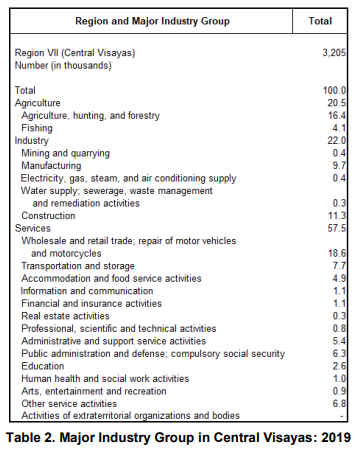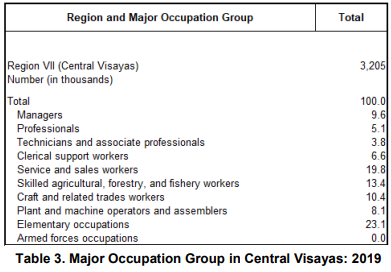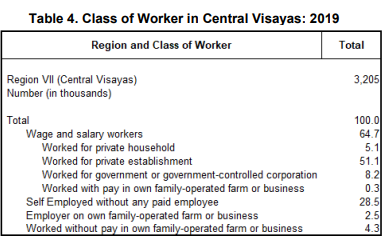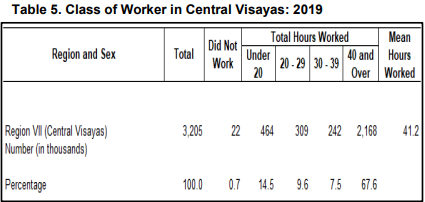62.3 percent of the population 15 years old and over are in the labor force
The Annual Labor and Employment Estimates for 2019 based on the average of the four (4) LFS rounds (January, April, July and October) reported an annual labor force participation rate of 62.3 percent out of the 5.4 million population in Central Visayas 15 years old and over. This is equivalent to about 3.4 million economically active population comprising of either employed and unemployed persons.
The annual employment rate in 2019 for Central Visayas was estimated at 94.8 percent. An equivalent of 3.2 million population of Central Visayas aged 15 years old and over; annual unemployment rate was estimated at 5.2 percent for 2019, which translates to 175.8 thousand population 15 years old and over; and underemployment rate was estimated at 14.9 percent, which translates to a 477.5 thousand population 15 years old and over.
The total employed persons in Central Visayas in the year 2019 was approximately 3.2 million. Workers were grouped into three broad sectors, namely, agriculture, industry and services sector. Workers in the Services Sector composed the largest proportion of the employed persons. These workers made up 57.5 percent of the total employed in 2019. Those engaged in the Wholesale and retail trade and repair of motor vehicles and motorcycles accounted the largest proportion of 18.6 percent of workers in the services sector.
Workers in the industry sector was the second largest group making up 22.0 percent of the total employed in 2019, while workers in the agriculture sector made up the smallest group registering 20.5 percent of the total employed (Table 2).

In 2018, workers in services sector composed the largest proportion (56.7%) of the employed persons, followed by workers in industry (22.0%) of the total employed, and workers in agriculture sector, 21.3 percent.
Among the occupation groups, workers in the elementary occupations remained the largest group making up 23.1 percent of the total employed in 2019 and 23.7 percent in 2018. Service and sales workers composed the second largest occupation group in 2019 which accounted to 19.8 percent, followed by skilled agricultural, forestry, and fishery workers (13.4%) and craft and related trades workers (10.4%) (Table 3).

Employed persons fall into any of these classes of workers: (1) wage and salary workers, (2) self-employed workers without any paid employee, (3) employers in own family-operated farm or business, and (4) unpaid family workers. Wage and salary workers are those who work for private households, private establishments, government and government-controlled corporations, and those who work with pay in own family-operated farm or business. In 2019, the wage and salary workers composed of 64.7 percent of the total employed, of which workers in private establishments accounted the largest share (51.1%), followed by workers in government and government-controlled corporations (8.2%), workers in private households (5.1%) and workers with pay in own family-operated farm or business (0.3%). The second largest class of workers were the self-employed without any paid employee making up 28.5 percent of the total employed in 2019. The unpaid family workers accounted for 4.3 percent, while the employer in own family-operated farm or business, 2.5 percent (Table 4).

Employed persons are classified as either full-time workers or part-time workers. Full-time workers refer to those who worked for 40 hours or more in a week, while those who worked for less than 40 hours were considered part-time workers. Of the total employed persons in 2019, 67.6 percent were full-time workers, while 31.7 percent were part-time workers. Those who did not report for work during the reference week comprised 0.7 percent (Table 5).

In 2018, full-time workers composed 67.1 percent of the total employed while part-time workers, 32.5 percent. The mean hours worked per week in 2019 is 41.2 and 41.5 in 2018.
By definition, employed persons who express the desire to have additional hours of work in their present job, or to have additional job, or to have a new job with longer working hours are considered underemployed. In 2019, the estimated number of underemployed persons was estimated at 477.5 thousand persons corresponding to an underemployment rate of 14.9 percent. In 2018, the underemployment rate was 17.8 percent. In 2019, unemployment in Central Visayas was estimated at 5.2 percent which is lower than the following regions: BARMM (6.6%), CALABARZON (6.1%), NCR (5.8%), and Ilocos Region (5.3%).
TECHNICAL NOTES The annual labor and employment statistics presented in this release for 2019 used the average estimates of labor and employment indicators from the four Labor Force Survey (LFS) rounds conducted by the Philippine Statistics Authority (PSA) on a quarterly basis. The use of the average estimates of the four-quarter rounds of the LFS data was based on PSA Board Resolution No. 01, Series of 2017-151 - Approving and Adopting the Official Methodology for Generating Annual Labor and Employment Estimates, approved on the 14th day of February 2017. For 2019, the methodology for annual labor and employment estimates uses the following formula to estimate employment, unemployment, underemployment and labor force participation rates: Zi= (∑j Xij / ∑j Ykj) x 100 where: Zi = annual estimate for the rate of i where i refers to employment, unemployment, underemployment and labor force participation Xij = estimate for the population of i for the jth round of LFS where i refers to employed, unemployed, underemployed and labor force, and j = refers to the four rounds of LFS: January, April, July and October Ykj = estimate for the population of k for the jth round of LFS where k = refers to labor force, employed persons and persons 15 years old and over, and j = refers to the four rounds of LFS: January, April, July and October The official methodology was deemed the most appropriate among methodologies reviewed and evaluated for the following reasons: a) it captures the labor and employment situation in all four quarters of the year; b) the generation or cross tabulations (e.g., by class of workers, by occupation group) is more feasible for producer of estimates; c) it is the closest method for estimating the number of persons who work four times for the entire year; and d) these estimates are being used by the Department of Labor and Employment (DOLE) and its attached agencies and regional offices for planning/formulation of intervention programs. |
Approved by:
(SDG.) ARIEL E. FLORENDO
Regional Director

